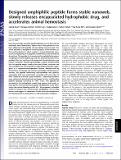Designed amphiphilic peptide forms stable nanoweb, slowly releases encapsulated hydrophobic drug, and accelerates animal hemostasis
Author(s)
Ruan, Liping; Zhang, Hangyu; Luo, Hanlin; Liu, Jingping; Tang, Fushan; Shi, Ying-Kang; Zhao, Xiaojun; ... Show more Show less
DownloadRuan-2009-Designed amphiphilic.pdf (975.2Kb)
PUBLISHER_POLICY
Publisher Policy
Article is made available in accordance with the publisher's policy and may be subject to US copyright law. Please refer to the publisher's site for terms of use.
Terms of use
Metadata
Show full item recordAbstract
How do you design a peptide building block to make 2-dimentional nanowebs and 3-dimensional fibrous mats? This question has not been addressed with peptide self-assembling nanomaterials. This article describes a designed 9-residue peptide, N-Pro-Ser-Phe-Cys-Phe-Lys-Phe-Glu-Pro-C, which creates a strong fishnet-like nanostructure depending on the peptide concentrations and mechanical disruptions. This peptide is intramolecularly amphiphilic because of a single pair of ionic residues, Lys and Glu, at one end and nonionic residues, Phe, Cys, and Phe, at the other end. Circular dichroism and Fourier transform infrared spectroscopy analysis demonstrated that this peptide adopts stable β-turn and β-sheet structures and self-assembles into hierarchically arranged supramolecular aggregates in a concentration-dependent fashion, demonstrated by atomic force microscopy and electron microscopy. At high concentrations, the peptide dominantly self-assembled into globular aggregates that were extensively connected with each other to form “beads-on-a-thread” type nanofibers. These long nanofibers were extensively branched and overlapped to form a self-healing peptide hydrogel consisting of >99% water. This peptide can encapsulate the hydrophobic model drug pyrene and slowly release pyrene from coated microcrystals to liposomes. It can effectively stop animal bleeding within 30 s. We proposed a plausible model to interpret the intramolecular amphiphilic self-assembly process and suggest its importance for the future development of new biomaterials for drug delivery and regenerative medicine.
Date issued
2009-03Department
Massachusetts Institute of Technology. Center for Biomedical EngineeringJournal
Proceedings of the National Academy of Sciences of the United States of America
Publisher
National Academy of Sciences
Citation
Ruan, Liping et al. “Designed amphiphilic peptide forms stable nanoweb, slowly releases encapsulated hydrophobic drug, and accelerates animal hemostasis.” Proceedings of the National Academy of Sciences 106.13 (2009): 5105-5110.
Version: Final published version
ISSN
0027-8424